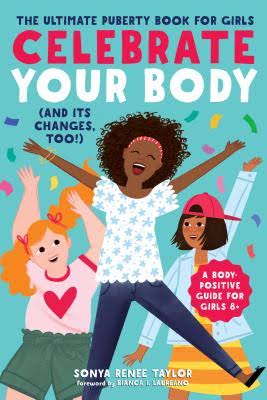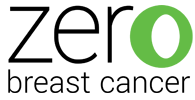
When we heard body positivity activist Sonya Renee Taylor, founder of TheBodyIsNotAnApology.com, wrote a girls’ puberty guide, we knew we had to check it out for ourselves. To borrow words from her website, Taylor has made it her mission to promote “radical self-love for everybody and every body.” That’s exactly what young girls need as they face major body changes during puberty, many of which can be uncomfortable physically, emotionally or socially.
Overview
“Puberty is a natural part of having a body. Everybody goes through it. You might want to think about it more like an exciting train ride than a high-drama adventure film. If you know where you are headed, puberty can be a wonderful journey and the perfect time to notice and learn about all the brilliant things your body will do on its way to adulthood” (2).
Celebrate Your Body (And Its Changes, Too!) provides girls with essential information about what they can expect from their developing bodies, as well as how to make healthy choices. Using a puberty train metaphor throughout, Taylor brings fun imagery to an intimidating topic. The illustrations are colorful and bright, but most importantly full of girls with different bodies, including various shapes, sizes, races and abilities.
The book has 8 chapters: 1) Fabulous You!; 2) Your Changing Body; 3) Breasts and Bras; 4) Below Your Belly Button; 5) Your Period; 6) Feeding and Fueling Your Body; 7) Feelings and Friends; and 8) Family and Other Safe Spaces. At the end, there is a glossary, index and more resources.
“Do you remember the three biggest ways you can help your body feel good and stay strong as you are going through puberty? You guessed it: nutritious food, fun movement and exercise, and a good night’s rest” (91).
The healthy actions topic areas toward the end of the book are right in line with 4 of the 5 Zero Breast Cancer’s Girls’ New Puberty campaign topics: moving more, eating healthy, getting enough sleep, and managing stress. (There is not a discussion of chemical exposures, which is not surprising in this type of a book.) Taylor provides practical tips to help girls make nutritious food decisions, move in ways that feel good for their bodies, and get the sleep they need to stay healthy. She also shares ways to deal with heavy emotions and how to identify a trusted adult to discuss puberty with.
Who it’s for
Intended for girls 8+, the language might be a little advanced for girls who start puberty early, but the material is not. If your girl is under 8, you can read it together. As with all books on development, regardless of her age, it’s a good idea to read it beforehand to add in your own advice or clarify points that you want her to understand a certain way.
Common ages for starting different areas of development are mentioned, with the young end of breast development noted at the age of 8. This could make younger girls feel uncomfortable that they are starting earlier, but Taylor assures throughout the book that your body knows when is the right time to develop for you. She also gently brings up precocious (early) puberty and suggests girls who are noticing changes earlier than age 8 “...talk with a trusted adult who can have a doctor check you out and make sure your puberty train is on the right schedule” (48). If her doctor has told you her development is normal, this section can be used to explain that, yes, she is starting breast development early but you’ve learned her body’s timeline is right for her. What’s important is feeling empowered throughout the process to establish healthy habits during puberty and beyond.
“For most girls, puberty can begin around 8 or 9 years old and usually lasts until they are around 16. Some girls will begin a bit earlier and some girls will start later. Every girl’s body is different, and puberty will begin at the time that is right for you” (3).
Taylor does empathize with girls who are feeling insecure about their bodies, but if your girl is feeling extra insecure it might feel a little light. Consider doubling down on the empathy yourself when sharing the book so that she can take in the positive perspective from a helpful starting point rather than feel her concerns are minimized.
“No matter how out of place you might feel during this time, there is one thing that remains true: you have an absolutely incredible body! No one else can be you, and it is your youness that makes you so special. Girls come in all shapes, sizes, colors, and abilities--and no one type is better than another” (10).
While the book is overall appropriate for girls who are in families with lower incomes, there is one area that might cause an issue. She mentions orthodontic care without attention to the cost, which unfortunately makes it out of reach for many girls who need it.
Like our Girls’ New Puberty campaign, this book is most appropriate for cis-gender girls (those who were assigned “female” at birth and continue to identify as female). This is something we’ve grappled with at Zero Breast Cancer, as has Taylor, without solving for it. In the introduction, Taylor says that the term “girl” is used throughout but kids can replace the word with whatever gender they identify with. She also provides some resources for trans kids and information about being transgender at the end of the book. For talking about chest changes and puberty with kids that are nonbinary or transgender, check out the resource “Principles of Gender-Inclusive Puberty and Health Education.” Although this resource was written for educators, parents and other caregivers can also get some ideas for how to talk with kids in a gender inclusive way.
Recommendation
Overall, we highly recommend Taylor’s body-positive book for young, cis-gendered girls. It presents basic facts about development in an engaging and empowering way, while also focusing on how to be healthy throughout puberty. Our Girls’ New Puberty campaign and the book complement each other well and can be used side-by-side to promote healthy puberty for young girls.
Reviewed by Lianna Hartmour, ZBC Program Director

